"Hi [Insert name]"
That simple customized greeting marked the dawn of digital personalization. As services like email, social media, and mobile apps emerged, they created a sense of recognition through tailored welcome messages. Industry pioneers like Amazon, Google, and Netflix then revolutionized how businesses connect with customers. Today, personalization has evolved far beyond these humble beginnings.
Modern users engage with content in increasingly sophisticated ways — searching, clicking, navigating back, clicking again, and browsing different pages. Every interaction generates valuable data that reveals deeper insights into their preferences and needs.
The transformation of personalization mirrors a familiar retail experience. In the late 1990s, visiting your neighborhood bookstore meant being greeted by an owner who knew your reading preferences. Knowing your appreciation for Agatha Christie's mysteries, they might recommend a new P.D. James novel. This personal touch was about to undergo a digital renaissance. When Amazon launched their recommendation system in 1998, they aimed to recreate this intimate bookstore experience at an unprecedented scale. Though rudimentary compared to today's technology, it laid the foundation for modern digital personalization.
The journey from static to dynamic personalization
The initial phase of online personalization centered on straightforward connections; Amazon's system generated recommendations based on purchase history. "If you bought this, you might like that." While groundbreaking at the time, it was merely the first step in a rapidly evolving landscape.

Example of early uses of personalization on amazon.com in 1998
Google's introduction of personalized search results in 2005 marked another milestone. Search engines recognized that identical queries could carry different intentions. A photographer's search for "Canon" likely relates to cameras, while a classical music enthusiast might seek Pachelbel's famous canon in D.
Netflix elevated personalization to new heights in 2011 by introducing contextual awareness. They expanded beyond simple preference tracking to consider timing and context: "What might this person want to watch right now?" Suddenly, your Netflix recommendations changed throughout the day – suggesting quick episodes during your morning commute and settling in with feature-length films in the evening.
The industry reached new maturity by 2018 when Algolia introduced personalization that merged search queries with user behavior. The technology had evolved from simple purchase memory to sophisticated understanding of user identity and anticipation of future needs.
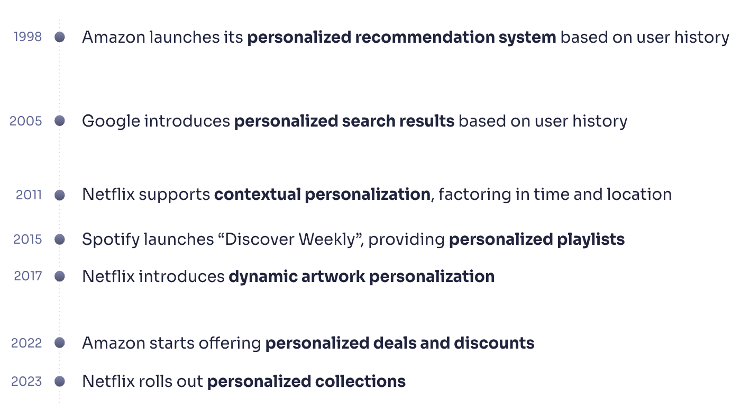 A A brief history of personalization
A A brief history of personalization
The 5 core principles of effective personalization
Effective personalization requires a delicate balance of technology and human-centered design. While the technology is widespread, implementation excellence remains crucial. Success depends on nuanced application and thoughtful synthesis of various elements. Through this lens, every user interaction tells a story.
Here are core principles that separate great personalization from mere customization:
1. Immediacy: the power of now
Every interaction should inform the next moment of the experience. When a user shows interest in running shoes, there’s no need to wait until their next visit to adjust their experience – respond immediately with relevant content while maintaining a natural flow.
2. Balance: the art of discovery
While comfort is important, discovery is essential. Your daily playlist doesn't repeat songs you've already heard. Balanced personalization strikes a harmony between showing users what they know they want and helping them discover what they didn't know they needed. It's about creating serendipitous moments within a familiar framework.
3. Transparency: building trust through understanding
Consider the way a trusted friend recommends a new restaurant: "I thought of you because you love Thai cuisine, and this place has exceptional vegetarian options." Similarly, effective personalization should make its recommendations clear and understandable to users, creating a relationship built on transparency and trust.
4. Privacy and Security: the foundation of trust
In an age where data privacy concerns are paramount, successful personalization must be built on a foundation of respect for user data. This means being intentional about what data you collect and transparent about how you use it. Think of it as the digital equivalent of doctor-patient confidentiality.
5. Measurability: the science behind the art
Effective personalization isn't just about implementing features – it's about understanding their impact. Bad personalization is worse than no personalization. Every personalization decision should be measurable against clear objectives, whether that's increased engagement, higher conversion rates, or improved user satisfaction.
Turning data into meaningful experiences
1. Data streaming: capturing user intents
Each click, scroll, and pause tells us something about what your users want – but like any good story, it needs interpretation. The challenge lies in distinguishing meaningful signals from random noise.
A typical user journey follows a natural progression:
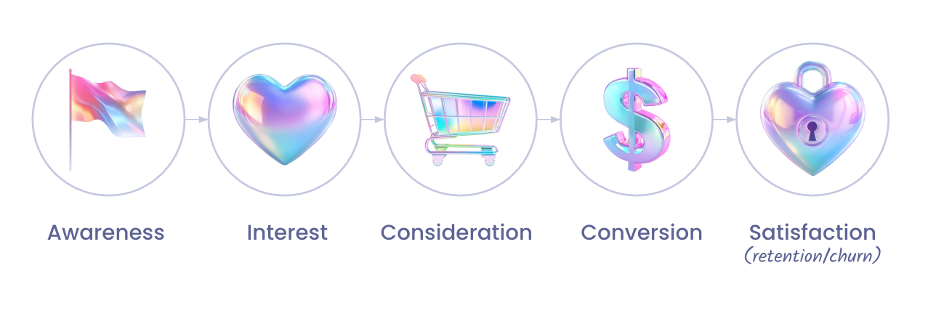
Consider a customer shopping for running shoes. They first notice a new model (Awareness), explore its details (Interest), compare various sizes and colors (Consideration), complete their purchase (Conversion), and eventually return for another pair or share their experience (Satisfaction). Each stage provides valuable signals about user preferences and intent, but the journey only makes sense when viewed holistically. The satisfaction phase is particularly crucial as it can validate or invalidate all previous assumptions – a return purchase confirms positive signals, while a refund may indicate our interpretations were incorrect.
2. Real-time processing: making sense of the intents
Once you've captured these signals, you need to process them immediately – turning raw data into actionable insights. This involves:
-
Computing preference scores: Weighing different actions (a quick glance vs. a detailed product review)
-
Generating machine learning features: Creating patterns the system can learn from
-
Combining current and historical data: Merging real-time actions with historical user profiles
-
Applying context: Considering factors like location, time, and current trends
This is where the magic happens – turning scattered data points into a coherent understanding of user preferences.
3. Real-time API: speed meets scale
For real-time personalization to work effectively, your API must meet several critical requirements:
-
Zero-latency response: The system must serve content in milliseconds
-
High concurrency support: Efficiently handle thousands of concurrent requests through proper load balancing
-
Minimal caching: Process fresh data to ensure personalization remains up-to-date
-
Robust error handling: Implement fallback mechanisms using historical preferences or cached preferences when real-time processing faces issues
The API must deliver a structured response containing all the essential elements for personalization:
This rich data payload provides everything needed to create personalized experiences in real-time.
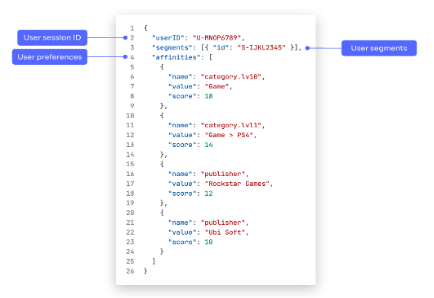
Example of user profile returned by the API
4. Adaptive UIs: turning API response into experiences
User engagement hinges on perfect timing in the personalization process. When a visitor first lands on your site, they're essentially a blank canvas – we know nothing about their preferences, so we begin with generic content. The story begins to unfold as they interact with your application.
Consider a typical shopping journey: a user discovers a hat, shows interest, and spends time considering it. This sequence of interactions provides enough signal strength to compute an initial version of their user profile. However, these new preferences only take effect when the user navigates to a different page. At this point, we've established their affinity for hats. The journey continues as they briefly glance at some glasses before moving directly to examine a shirt, where they spend considerable time exploring details. This behavior allows us to compute an even richer version of their profile, which we apply during their next navigation.
A crucial consideration for web platforms is maintaining temporal consistency. When users navigate backward (using the browser's back button), we must load their profile to its previous state at that point in time. This attention to temporal consistency ensures data integrity and delivers an experience that aligns with users' natural browsing expectations.
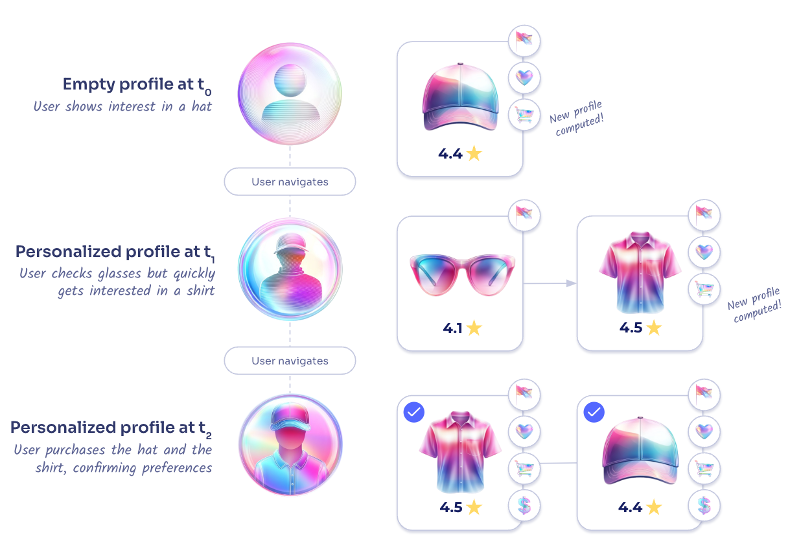 The journey of an adaptive user experience
The journey of an adaptive user experience
Let's examine how this personalization flow translates into code using the Remix web framework. The implementation consists of two key components:
-
A loader function that retrieves the session user profile
-
A component that provides this profile throughout the application tree
Remix's architecture is particularly well-suited for personalization, as it automatically revalidates the loader function both on initial page load and subsequent navigations, ensuring our user profile stays current throughout the session.
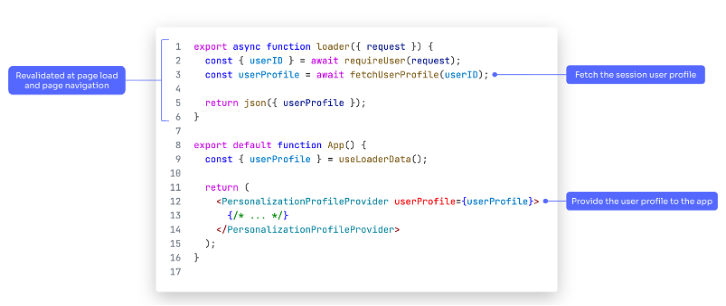
Fetching a user profile with the Remix web framework
You can build your own components and compose them here – free shipping or particular recommendations, for example.

Offering free shipping based on segmentation

Showing personalized recommendations
Breaking free from the filter bubble
Perhaps the greatest challenge in personalization isn't technical – it's philosophical. How do we create experiences that are personally relevant without trapping users in an echo chamber of their own preferences?
The answer lies in what we might call "mindful personalization." This approach combines three key strategies:
1. Strategic activation: Personalization decisions should be based on comprehensive data collection. Your system activates personalization only after gathering sufficient events to understand user preferences or successfully matching users to relevant profiles through collaborative filtering.
2. Layered implementation: Personalization operates on a spectrum, not as a binary choice. The approach ranges from subtle content visual adjustments to significant experience modifications. Three key implementation layers emerge:
- Content appearance (Netflix's dynamic artwork)
- Content boosting (Algolia's personalized search results)
- Content filtering (Algolia's personalized recommendations)
3. Dynamic memory: Like human relationships, personalization systems should evolve through carefully calibrated time decay algorithms. This approach keeps recommendations relevant and current, with recent interactions carrying more weight while older ones gradually fade. Slow decay works well for stable preferences within sessions, while fast decay suits applications where interests change rapidly.
The Future of Personalization
As we look ahead, personalization is evolving from a feature into an essential aspect of human-computer interaction. The goal isn't just to predict what users want – it's to create interfaces that feel alive, responsive, and genuinely helpful.
Effective personalization creates experiences that make users feel understood and valued. However, this connection is fragile – the joy of being listened to vanishes when we are misunderstood.
The technology to create these experiences is here. The challenge now is to use it wisely, always keeping in mind that the ultimate goal of personalization isn't just to serve content – it's to serve people.
Watch my DevCon webinar, The living interface: Real-time personalization principles.
Learn more about search personalization from Algolia.
AI Search
The results users need to seeAI Browse
Category and collection pages built by AIAI Recommendations
Suggestions anywhere in the user journeyAdvanced Personalization
Tailored experiences drive profitabilityMerchandising Studio
Data-enhanced customer experiences, without codeAnalytics
All your insights in one dashboardUI Components
Pre-built components for custom journeys






